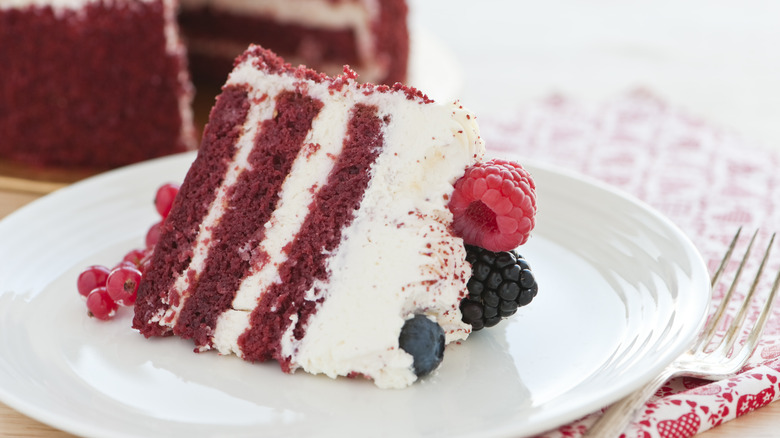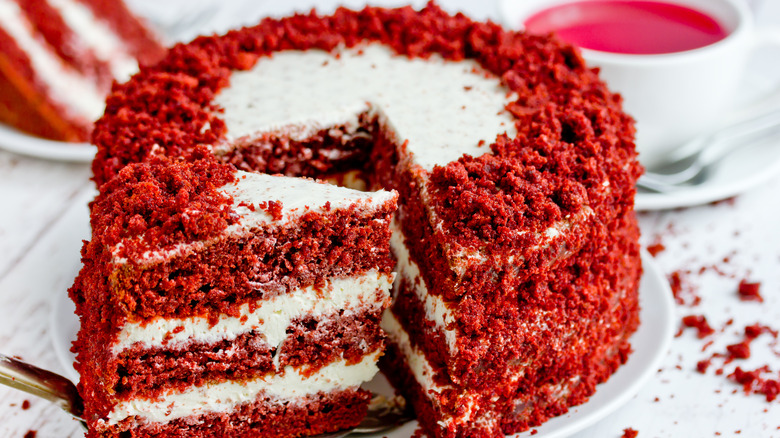Here's What We Really Know About The History Of Red Velvet Cake
Love it or hate it, there's no denying red velvet cake makes a statement. Exactly what that statement is, though, is a matter of debate. Is the devilishly tinted confection an homage to old-world baking? Or is its presence on modern-day tables rooted in a strategic — and decidedly successful — mid-20th-century marketing plan? Maybe it's a bit of both.
Earliest references to red velvet cake, or at least its precursor velvet cake, date to the Victorian Era when bakers employed by high-society families began experimenting with ways to create a lighter confection to rival more traditional dense and often fruit-laden cakes. Before the introduction of steel-roller milling, flour was coarse. Eventually, bakers realized that incorporating cocoa into the blend helped break down the grainy flour, paving the way for lighter — dare we say velvety? — desserts. To be clear, we weren't the first to use the term velvety to describe the fluffier confections. The consistency of the cocoa-infused cake was so smooth, at least in comparison to its chewy predecessor, that it became known as velvet cake.
That's right. Velvet cake. Not red velvet cake. By some accounts, the cocoa gave the cake batter a reddish tint, the result of a chemical reaction that caused the cocoa to turn red when it was mixed with baking soda and buttermilk, but it wasn't vibrant red. More likely, the resulting cake was a tone of reddish mahogany. The bright red color we associate with red velvet cake came later. And it wasn't all natural.
Redder is better
One of the more pervasive stories of the genesis of red velvet cake involves New York City's Waldorf Astoria Hotel. While it's unlikely anyone at the iconic hotel invented red velvet cake, it's safe to say their early-20th-century version that pushed the confection into the limelight is a derivation of cocoa-based velvet cake — but it wasn't bright red. That tweak was the brainchild of John A. Adams. The owner of Adams Extract Company had a redder-is-better eureka moment while sampling the cake at the hotel. He developed his own version of the recipe, using red food coloring to amp up the ruby hue.
Adams' timing was spot on. The Adams Extract Company introduced its artificially colored red velvet cake recipe at about the same time World War II food rationing was making it difficult to find key ingredients like cocoa and butter. Creative bakers who had been turning to an unlikely ingredient — beet juice — to maintain the confection's signature red hue embraced red food coloring as an easy fix. While it would be logical to assume red food coloring ultimately replaced beet juice, that's not what happened. Turns out the beet juice created an ultra-moist cake. Red food coloring is still a key ingredient in standard recipes, but some cooks opt instead for beet juice as a natural coloring agent.
What about Adams' inspiration, the Waldorf Astoria Cake? The iconic hotel brand (now a member of Hilton Hotels) stuck with beet juice. The brand's official recipe calls for 1½ pounds of beets, preferably fresh, drained and puréed.

